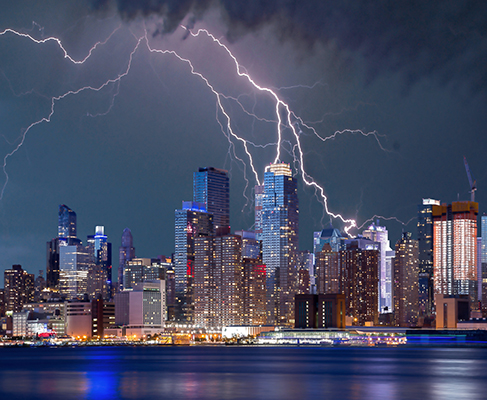Lightning strikes can be breath-taking and destructive at the same time. As modern structures rise into the skyline, the importance of effective lightning protection has never been more critical, says local lightning protection company Lightning Protection Concepts. However, navigating the intricate web of standards and implementing proper safeguards is a challenge that is often underestimated. Here is a look at the pitfalls of incorrect lightning protection and the consequences businesses and individuals face when they overlook this elemental necessity.

1. Structural damage: A bolt from the blue
The most immediate and visible consequence of inadequate lightning protection is structural damage to your building. When lightning strikes a structure without proper safeguards, it can cause fires, explosions and severe damage to the structure itself. Inadequate or poorly installed lightning rods, grounding systems and surge protection devices leave buildings vulnerable to the destructive power of lightning, putting lives and property at risk.
2. Equipment and electronic damage: The silent surge
Modern businesses are highly dependent on electronic systems and sensitive equipment. Incorrect lightning protection leaves these assets exposed to power surges induced by lightning strikes. Unprotected power lines and data cables become conduits for electrical surges, leading to the destruction of computers, servers and other critical infrastructure within the building. The financial toll of replacing or repairing damaged equipment can be staggering, not to mention the potential loss of valuable data. Should your insurance company find that your protection system was incorrectly installed, they will also not cover your loss and you will be further jeopardised.
3. Fire hazard: Igniting the unseen flames
Lightning-induced fires are a genuine concern for structures lacking proper protection. When a lightning strike occurs, the immense heat generated can ignite flammable materials within a building as well as the building structure itself in the case of timber-constructed buildings and thatch roofs. In the absence of robust protection measures, fires can quickly spread, turning a lightning strike into a catastrophic blaze that endangers lives and exacerbates property damage.
4. Safety risks for occupants: A shocking reality
The safety of occupants within a structure is paramount. Incorrect lightning protection exposes individuals to significant risks. Without a comprehensive protection system in place, lightning can induce dangerous electrical currents within a building, leading to shock hazards. Proper grounding and bonding are essential to channelling lightning safely to the ground, minimising the risk of injury or death to people inside.
5. Legal and insurance ramifications: Financial thunderclaps
Neglecting proper lightning protection can lead to significant issues in the legal and insurance realms. Insurance providers often mandate compliance with lightning protection standards to mitigate the risk of property damage. In the event of a lightning-related incident, an inadequate or absent protection system may lead to insurance claims being repudiated, leaving individuals and businesses to bear the full financial burden of repairs and replacements, with the insurance company then demanding the insured party install a compliant system or have their policy cancelled.
6. Operational downtime: A storm in productivity
Beyond the immediate physical and financial repercussions, incorrect lightning protection can result in significant operational downtime. Businesses may face interruptions due to damaged equipment, data loss or structural repairs. This downtime not only affects productivity but can also harm a company’s reputation and customer relationships.
7. Environmental impact: Thunderbolts and green consequences
Environmental sustainability is of global importance and significance now, and the ecological impact of incorrect lightning protection should not and must not be overlooked. Lightning-induced fires can lead to widespread deforestation and contribute to air pollution. Sustainable lightning protection solutions, such as eco-friendly materials and energy-efficient grounding systems, can help mitigate these environmental consequences.
In a world that is increasingly interconnected and dependent on technology, correct lightning protection and the importance thereof cannot be overstated. From the immediate risks of structural damage and fire hazards, to the long-term consequences of legal liabilities and environmental impact, the pitfalls of inadequate protection are varied and significant.
Businesses and individuals must recognise that lightning is not a force to be underestimated. It requires a holistic approach to protection that includes proper grounding, lightning rods, surge protection and adherence to industry standards. By investing in comprehensive lightning protection measures, we not only shield ourselves from the immediate dangers of a lightning strike but also fortify our structures against the silent and lingering aftershocks that can reverberate for years to come. It’s time to illuminate the path to safety and resilience in the face of nature’s electrical fury.
Enquiries: www.lpconcepts.com





